Ducks Unlimited Protects and Restores Critical Habitat in Southern Region of U.S.
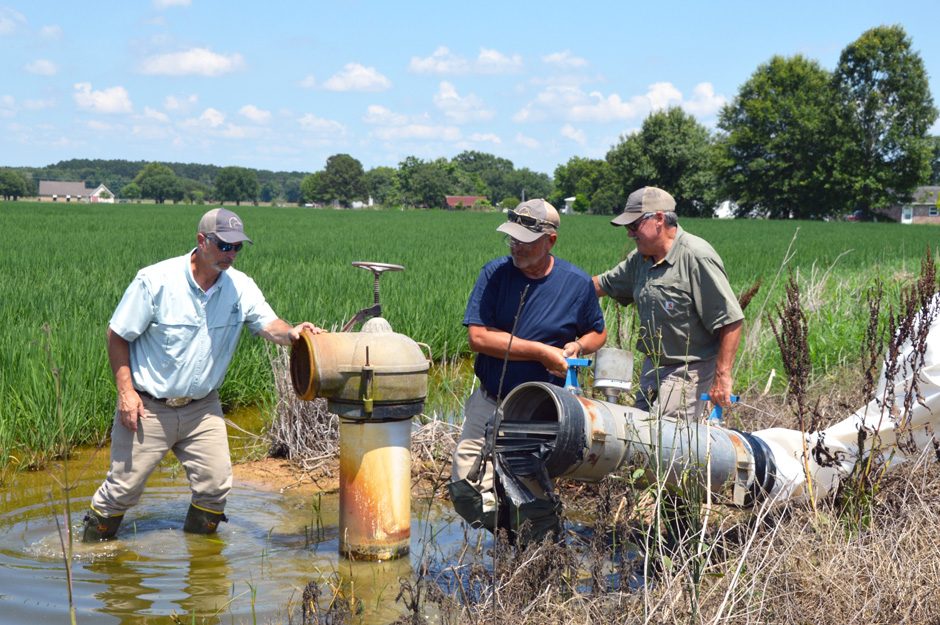 Rice Stewardship staff set up a pump test to measure water flowing from a discharge valve into a rice field. The exact gallons per minute discharged is measured at various running speeds to determine the most efficient rate for a producer to manage irrigation, saving input costs and energy. (Photo by: Andi Cooper, DU)
Rice Stewardship staff set up a pump test to measure water flowing from a discharge valve into a rice field. The exact gallons per minute discharged is measured at various running speeds to determine the most efficient rate for a producer to manage irrigation, saving input costs and energy. (Photo by: Andi Cooper, DU)“For many years, wetlands were viewed as something that needed to be fixed,” says Andi Cooper, Communications Specialist with Ducks Unlimited, Southern Region. “But in the 1970s, around the beginning of Earth Day, people started realizing that wetlands provide vital functions beyond waterfowl and other wildlife, like providing flood and storm protection. They started to understand that it was important to preserve wetlands.”
In the Southern Region, Ducks Unlimited is hard at work conserving and restoring wetlands, especially the wetlands associated with rice agriculture, which provide a critical food source for migrating waterfowl. While a gradual change in attitude towards wetlands has helped to conserve what remains, in the many years prior, a large percentage of these wetlands were lost to development. “Even today, wetlands are still being lost,” says Cooper. However, by working with farmers to keep the working wetlands provided by ricelands, along with other strategies, Ducks Unlimited has helped slow and even reverse the trend of wetland loss.
The Southern Region of Ducks Unlimited consists of 13 states with diverse geographies. The territory includes New Mexico and Texas, including Gulf Coast habitat, all the way to Virginia.
Ducks Unlimited participates in many kinds of habitat protection and restoration activities in the Southern Region, including those involving: wetlands restoration, water management, infrastructure, geomorphology, hydrology, pumps, wells, levees and dams. The work they do is key for both public and private lands. In Texas and Louisiana especially, they focus on water management infrastructure, water control infrastructure, saltwater management, dredge material projects and shoreline protection to prevent coastline erosion.
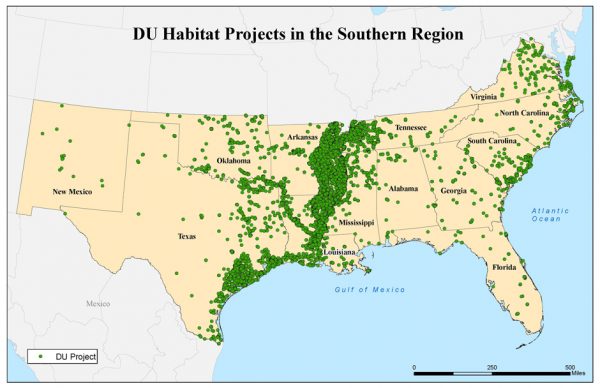
Ducks Unlimited Southern region project map 2012. (Photo provided by Ducks Unlimited)
Ducks Unlimited also performs some major conservation and restoration work in the Mississippi Alluvial Valley (MAV), from the southern Illinois confluence of the Ohio and Mississippi Rivers to freshwater swamps by the Mississippi River. The Mississippi River waters ultimately drain towards the Gulf of Mexico. The MAV covers about 24 million acres of land, once largely floodplain forests, swamps, sloughs and riverine habitat, but now largely deforested. Ducks Unlimited delivers much of the Natural Resource Conservation Service’s Wetland Reserve Program (WRP) in the MAV, which partners with landowners in the region to reforest and restore wetlands in the MAV.
On the South Atlantic coast, Ducks Unlimited has been performing conservation and restoration work through conservation easements that come from landowners who have donated certain rights, such as development, on their land or made it available at a bargain price. The value of these conservation easements can then be used to secure other funding that Ducks Unlimited uses to restore public lands in the area.
In Arkansas, Mississippi, Louisiana, Texas, Missouri and California especially, Ducks Unlimited works with rice farmers to improve their water, nutrient and energy use efficiencies for their crops, while at the same time managing the land so it will be most beneficial for wildlife to use as well. “Rice is very important for waterfowl. It’s important for people across the world, too. We try to help farmers manage their rice fields so that it works best for both wildlife and farm profitability,” says Cooper.
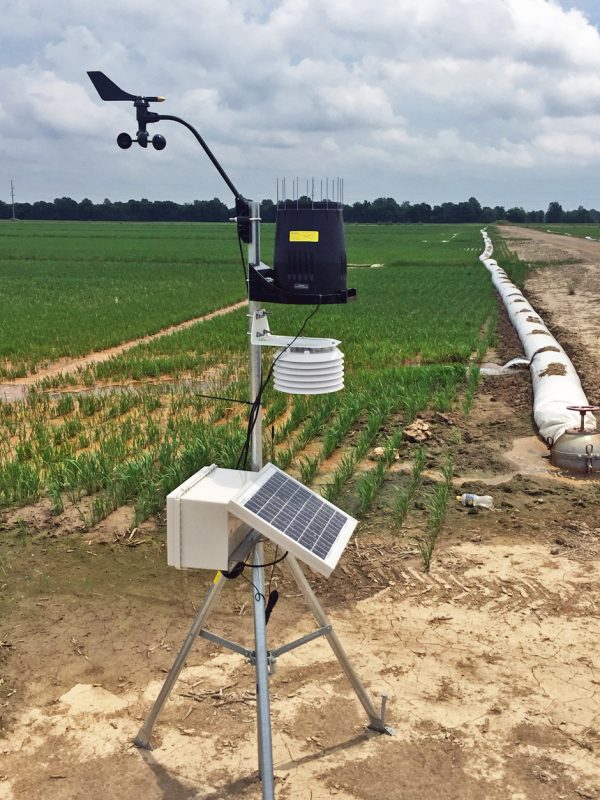
A weather station with telemetry allows a producer to see real time the weather conditions of his field, thereby improving water management. (Photo by: Tim Huggins, Delta FARM)
While Ducks Unlimited maintains a mission focus on waterfowl habitat, its wetland conservation work has many more far-reaching outcomes for people as well. “We have been helping to conserve natural areas for more than 80 years. In the past couple years we have started trying to measure more of the ecosystem goods and services from our conservation projects. Ecosystem goods and services refer to the many benefits: better flood control, clean water and climate regulation wetlands provide,” Cooper explains. “Our rice program is the poster child for our efforts to quantify these outcomes.”
When working with rice farmers, Ducks Unlimited uses a strategy of managing wetland habitat that includes a cycling of “water on” (to flood the fields) and “water off” (draining the fields to harvest the rice). Wetlands naturally are not wet all the time, they have wet and dry periods throughout the year, which helps management of vegetation. “The rice field wetlands are great at cleaning up water. There is a five-fold decrease in sediment, as the rice plants filter it out. We have measured the ‘water on’ sediment concentration as 339 mg/L, but the ‘water off’ measurement decreased all the way down to 63 mg/L, after natural rice wetland filtration,” says Cooper. “If you look at, say, muddy bayou water at the ’water on‘ phase, after a few weeks, you can see a physical difference in the water. By the ’water off‘ or harvesting phase, the water has gone from muddy to clear. The rice wetland has cleaned the water, and you can see it with your own eyes.”
While Ducks Unlimited helps many wild species, there are a few species in particular that are being carefully monitored. Ducks Unlimited is keeping an eye on pintail populations in particular as their community is below the long-term average. The Gulf Coast areas of Texas and Louisiana Gulf are particularly important for wintering pintails, and some research has indicated that insufficient wintering habitat may be impacting the population.
Ducks Unlimited is able to do such extensive research in the Southern Region by partnering with area experts in a variety of disciplines. In the Southern Region, Ducks Unlimited works with Texas A & M, Louisiana State University, Mississippi State University, the University of Arkansas and others to develop the latest knowledge and expertise in waterfowl research, wetland restoration techniques, and rice agricultural matters. In addition to its academic partners, Ducks Unlimited has more than 40 other partners that support its Rice Stewardship Partnership, including Walmart, Nestlé Purina and the National Fish and Wildlife Foundation.
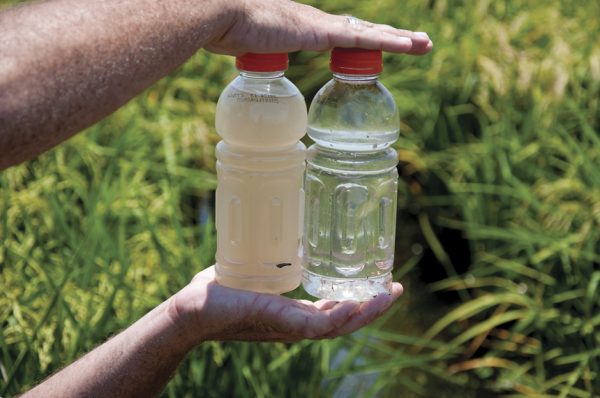
In just three weeks, there is a visible difference in the sediment load of water pumped onto a rice field compared to water released from the rice field. The rice fields act like natural wetlands to filter sediment and nutrient loads, cleaning water and enhancing downstream water quality. (Photo provided by Ducks Unlimited)
Ducks Unlimited actively works with farmers in the Southern Region to adopt best practices for rice cultivation that will benefit them and also wildlife that depend on their rice fields. “One of the things we help farmers adopt is practices that enable them to make the most of rainwater and minimize the use of groundwater. We have experts working with them to determine how to best utilize water in the rice growth cycle,” says Cooper. Arkansas and Mississippi farmers, for example, are adopting alternate wetting and drying (AWD) techniques. “On the 27,000 acres that AWD has been implemented, farmers have saved about 19,000-acre feet of groundwater by switching to these practices, which is about the size of 9,200 Olympic-sized swimming pools. The practice also reduces anaerobic processes that go on in flooded rice fields, which in turn reduces production of greenhouse gases and also cuts down on the need to pump water. The amount of greenhouse gas reduction by adopting these agricultural methods is the equivalent of getting 4,500 cars off the highways for a year. We partner with USA Rice to get the farmers the best knowledge and agricultural techniques we can for growing rice.”
Different areas of the Southern Region have different geographies and different requirements for success. “For example, when we started working with rice farmers in Louisiana, we started with the question: ‘What do the farmers need?’ We tried to get a list of what they needed and provided them with expertise. Then we fit what they needed into overall wildlife habitat needs,” says Cooper. “The needs of farmers can include anything related to rice field planting and maintenance, including water pump efficiency testing and water management.”
“We started in Louisiana because of the rates of coastal marsh loss there. Preserving Gulf Coast ricelands is very important for waterfowl,” Cooper mentions. “The Louisiana and Texas Gulf Coast winter-flooded ricelands provide 42% of the available food for wintering dabbling ducks.”
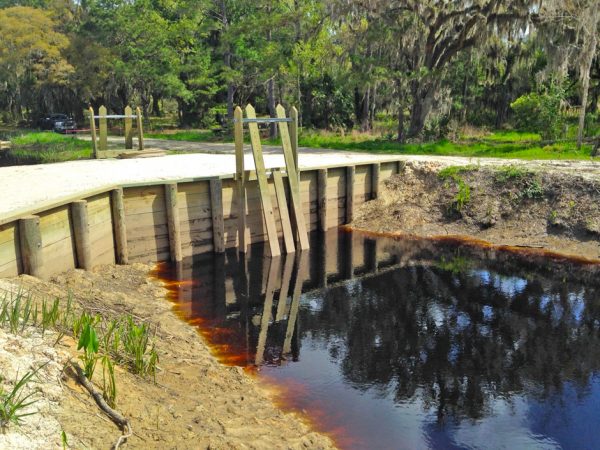
This is an installed rice trunk on the ACE Basin National Wildlife Refuge in South Carolina. (Photo courtesy of Ducks Unlimited)
More about them here: http://www.scencyclopedia.org/sce/entries/rice-trunks/
Ducks Unlimited also is active in the reforestation and restoration of wetlands in the Mississippi Alluvial Valley. An impact assessment was performed in 2016, and conservation projects in the area provided the water storage equivalent of 33.3 billion gallons, enough to provide daily water to 83,287 U.S. homes. Wetlands in the MAV have a huge ability to process water. The Mississippi River drains 41 percent of the country. Restoration of wetlands in the MAV also reduces excessive nitrogen levels in waterways that contribute to the dead zone in the Gulf. Ducks Unlimited projects reduced nitrogen by the equivalent of 7.6 million pounds of fertilizer, enough to fertilize 33,000 acres of corn. “Most of the dead zone is due to nutrient runoff throughout the MAV,” Cooper mentions. “Levees prevent the Mississippi River water from getting into its own natural floodplain, so it goes into the Gulf instead.”
Having worked at Ducks Unlimited for 12 years, Cooper says, “The diversity of our programs across the region and our supporters has surprised me. There are things I’ve seen while working here that I’ve never seen before.” One of these things, Cooper recalls, was the rice trunk, a water control structure, often found in Georgia, North Carolina and South Carolina. “South Carolina was one of the first places to grow rice,” says Cooper. “That’s where I saw my first rice trunk.” The rice trunk allows inflow and outflow of water in a passive structure, designed to manage salinity levels and flood water. “What was ordinary for them was pretty wild for me,” she laughs. “I think a passive structure like that was a stroke of genius.”




0 comments